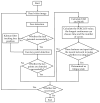Fatigue Driving Detection Method Based on Combination of BP Neural Network and Time Cumulative Effect
- PMID: 35808213
- PMCID: PMC9269348
- DOI: 10.3390/s22134717
Fatigue Driving Detection Method Based on Combination of BP Neural Network and Time Cumulative Effect
Abstract
Fatigue driving has always received a lot of attention, but few studies have focused on the fact that human fatigue is a cumulative process over time, and there are no models available to reflect this phenomenon. Furthermore, the problem of incorrect detection due to facial expression is still not well addressed. In this article, a model based on BP neural network and time cumulative effect was proposed to solve these problems. Experimental data were used to carry out this work and validate the proposed method. Firstly, the Adaboost algorithm was applied to detect faces, and the Kalman filter algorithm was used to trace the face movement. Then, a cascade regression tree-based method was used to detect the 68 facial landmarks and an improved method combining key points and image processing was adopted to calculate the eye aspect ratio (EAR). After that, a BP neural network model was developed and trained by selecting three characteristics: the longest period of continuous eye closure, number of yawns, and percentage of eye closure time (PERCLOS), and then the detection results without and with facial expressions were discussed and analyzed. Finally, by introducing the Sigmoid function, a fatigue detection model considering the time accumulation effect was established, and the drivers' fatigue state was identified segment by segment through the recorded video. Compared with the traditional BP neural network model, the detection accuracies of the proposed model without and with facial expressions increased by 3.3% and 8.4%, respectively. The number of incorrect detections in the awake state also decreased obviously. The experimental results show that the proposed model can effectively filter out incorrect detections caused by facial expressions and truly reflect that driver fatigue is a time accumulating process.
Keywords: Adaboost algorithm; BP neural network algorithm; cascade regression tree; fatigue driving detection; time accumulation effect.
Conflict of interest statement
The authors declare no conflict of interest.
Figures










Similar articles
-
A dense multi-pooling convolutional network for driving fatigue detection.Sci Rep. 2025 May 3;15(1):15518. doi: 10.1038/s41598-025-99441-7. Sci Rep. 2025. PMID: 40319134 Free PMC article.
-
Real-Time Fatigue Detection Algorithms Using Machine Learning for Yawning and Eye State.Sensors (Basel). 2024 Dec 6;24(23):7810. doi: 10.3390/s24237810. Sensors (Basel). 2024. PMID: 39686347 Free PMC article.
-
R2DS: A novel hierarchical framework for driver fatigue detection in mountain freeway.Math Biosci Eng. 2020 Apr 29;17(4):3356-3381. doi: 10.3934/mbe.2020190. Math Biosci Eng. 2020. PMID: 32987533
-
Driver fatigue detection based on eye state.Technol Health Care. 2015;23 Suppl 2:S453-63. doi: 10.3233/THC-150982. Technol Health Care. 2015. PMID: 26410512
-
A Memristive Circuit Implementation of Eyes State Detection in Fatigue Driving Based on Biological Long Short-Term Memory Rule.IEEE/ACM Trans Comput Biol Bioinform. 2021 Nov-Dec;18(6):2218-2229. doi: 10.1109/TCBB.2020.2974944. Epub 2021 Dec 8. IEEE/ACM Trans Comput Biol Bioinform. 2021. PMID: 32086217
Cited by
-
Rapid Identification of Wild Gentiana Genus in Different Geographical Locations Based on FT-IR and an Improved Neural Network Structure Double-Net.Molecules. 2022 Sep 14;27(18):5979. doi: 10.3390/molecules27185979. Molecules. 2022. PMID: 36144717 Free PMC article.
-
Air traffic controller work state recognition based on improved xception network.PLoS One. 2025 May 7;20(5):e0322404. doi: 10.1371/journal.pone.0322404. eCollection 2025. PLoS One. 2025. PMID: 40334013 Free PMC article.
-
A high-efficiency palmprint recognition model integrating ROI and Gabor filtering.PLoS One. 2025 Jun 2;20(6):e0323373. doi: 10.1371/journal.pone.0323373. eCollection 2025. PLoS One. 2025. PMID: 40455870 Free PMC article.
-
A Multimodal Feature Fusion Framework for Sleep-Deprived Fatigue Detection to Prevent Accidents.Sensors (Basel). 2023 Apr 20;23(8):4129. doi: 10.3390/s23084129. Sensors (Basel). 2023. PMID: 37112470 Free PMC article.
-
A Novel Neural Network Model Based on Real Mountain Road Data for Driver Fatigue Detection.Biomimetics (Basel). 2025 Feb 12;10(2):104. doi: 10.3390/biomimetics10020104. Biomimetics (Basel). 2025. PMID: 39997127 Free PMC article.
References
-
- Zhao Z., Zhou N., Zhang L., Yan H., Xu Y., Zhang Z. Driver Fatigue Detection Based on Convolutional Neural Networks Using EM-CNN. [(accessed on 20 May 2022)]. Available online: https://www.hindawi.com/journals/cin/2020/7251280/ - PMC - PubMed
-
- Chen L., Xin G., Liu Y., Huang J. Driver Fatigue Detection Based on Facial Key Points and LSTM. Secur. Commun. Netw. 2021;2021:5383573. doi: 10.1155/2021/5383573. - DOI
-
- Zhang L., Yang D., Ni H., Yu T. SAE-China 2017: Proceedings of the 19th Asia Pacific Automotive Engineering Conference & SAE-China Congress 2017: Selected Papers. Volume 486. Springer; Singapore: 2017. Driver Fatigue Detection Based on SVM and Steering Wheel Angle Characteristics; pp. 729–738. (Lecture Notes in Electrical Engineering).
MeSH terms
Grants and funding
- BK20190873/Natural Science Foundation of Jiangsu Province
- JGLX2021_002/Graduate Education Reform and Practice Project of Yangzhou University
- SJCX21_1557/Postgraduate Research and Practice Innovation Program of Jiangsu Province
- Jian Chen and Xiaoguang Sun/Lvyang Jinfeng Plan for Excellent Doctors of Yangzhou City
- 52005435/National Natural Science Foundation of China
LinkOut - more resources
Full Text Sources

